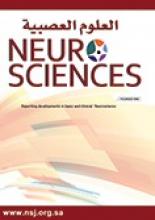Abstract
OBJECTIVE: To study the clinical characteristics, electroencephalographic and computerized axial tomography profile in Saudi children with cerebral palsy who suffer epilepsy in a university referral center.
METHODS: A total of 113 patients with cerebral palsy and epilepsy was seen (67 boys, 46 girls) with an over all mean age 5.3 years (range .2-12 years) during the study period (January 1998 - December 1999). They all had clinical evaluation and standardized electroencephalographic studies interpreted by the same examiner.
RESULTS: The main clinical features were language delay (61%), hypotonia (45%), hypertonia (38%), and behavioral abnormalities (41%). Seizure types included generalized in 96 (85%), and partial and complex partial with or without secondary generalization in 17 (15%). None of the patients had simple partial seizures. The generalized seizures were non-convulsive in 4 patients (3.5%), tonic/clonic 73 (65%), atonic 3 (3%), myoclonic 16 (14%), and mixed 2 (2%). Inter-ictal electroencephalographic abnormalities were epileptiform activity, generalized in 65 (57.5%) and focal 18 (16%), slow-wave activity in 58 (51%) and hypsarrythmia pattern in 6 (5%). Only 9 patients had normal electroencephalogram. The cranial computerized tomography findings were normal in 11.5%. The main abnormalities were cerebral atrophy (65%), hydrocephalus (8%) and agenesis of the corpus callosum (8%).
CONCLUSION: The pattern of seizure type in patients with cerebral palsy and types of electroencephalogram abnormalities electroencephalogram and cranial computerized tomography are comparable to the results from studies in other clinical settings and environments.
- Copyright: © Neurosciences
Neurosciences is an Open Access journal and articles published are distributed under the terms of the Creative Commons Attribution-NonCommercial License (CC BY-NC). Readers may copy, distribute, and display the work for non-commercial purposes with the proper citation of the original work.






